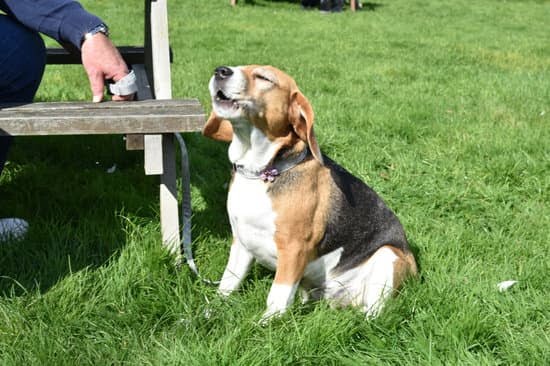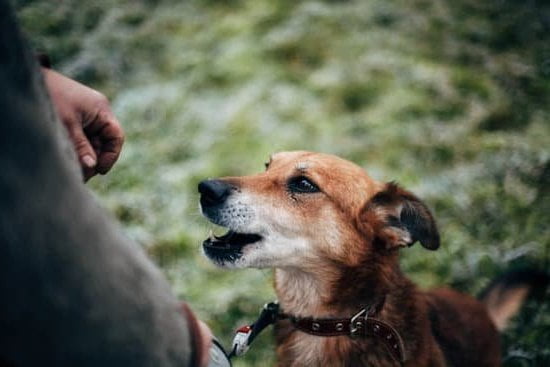Introduction
Collar training is a popular technique used to help dogs learn how to walk on a leash. It involves outfitting your dog with either an adjustable buckle collar or a slip collar. These collars are designed to gently but firmly provide reminders to your pet that tugging or pulling on the leash is not allowed, and in turn prevents the pet from wandering off. With time, patience, and dedication to the process, you can use collar training as an effective tool to train your pooch how to mind their manners when walking on a leash- such as not barking at other people or pets along the way!
Collaring training is beneficial for many reasons; it helps establish good control of your dog so they will obey certain commands while walking on a leash. Additionally, it teaches them how to remain close by your side and stay near you during any activity. The process begins by having your dog wear one of the two types of collars often referenced above during short exercise sessions. As you gradually increase these sessions in length and frequency, you should eventually begin rewarding them for their appropriate behavior such as walking calmly beside you and paying attention when called upon. You should also incorporate commands such as “heel” into walks on occasion as this reinforces that they should remain by your side regardless if there are distractions (e.g., other people or pets) present or not. Over time, this type of collar training can have lasting benefits; especially if accompanied with consistent reinforcement and respect between both parties involved -both owner and pet alike!
Understanding the Different Types of Collars Used for Training
Using a collar to train a dog to walk properly is a great way to ensure that your pup follows the rules when you are out for a walk. There are many different types of collars available for training purposes, so it is important to understand the capabilities and limitations of each before selecting one.
Choke or slip collars, also known as “check” collars, use a link chain or cord that will tighten around the dog’s neck when pulled on. These are one of the most common types of collars and can be quite effective if used correctly with consistency. Martingale collars, sometimes called Greyhound or Whippet collars, use two loops in order to provide more control but still remain comfortable for the dog. They have limited tightening capabilities and can be easily slipped off by overly active dogs. Head halters are often seen on larger breeds of dogs and serve as an effective way to train them while allowing full range of motion and preventing against choking sensations. Finally, harnesses provide more stability with straps connecting around both the chest and back areas providing even weight distribution throughout their body which makes it easier for you to keep your pooch under control.
How to Properly Fit Your Collar to Your Dog
Fitting a collar to your dog is an important part of training them to walk. A properly fitted collar can help prevent damage done to your pet’s neck and reduce their chance of escaping while they are being walked. It is extremely important that you check the fit on a regular basis and make necessary adjustments as needed. Here are some tips for getting the right fit:
1. Measure your dog’s neck first – Make sure that the collar you choose is the appropriate size for your dog by using a fabric measuring tape to measure the girth of their neck when they are standing upright. You can usually find this measurement in inches by looking at the size charts found online or on the packaging.
2. Select the appropriate material – You should select a collar that is made from a sturdy material such as nylon, leather or webbing, rather than one with weak buckles or snaps that could potentially break during use. When selecting an adjustable collar, make sure that it has several holes for easy adjustment depending on your pet’s growth over time.
3. Ensure a comfortable fit – The goal is to make sure that the collar fits snugly against your dog’s neck, but not too tight where it will choke them when pulled on during training exercises or while going for walks. When fitting the collar be sure to leave two fingers distance between it and their skin so you can ensure comfortability and prevention of irritation when in use.
4. Use additional safety devices – Some collars come with built-in safety features such as break away clips which will cause them to loosen if they become caught in something stronger than itself like underbrush during walks, or reflective materials applied to increase nighttime visibility.. Consider adding these options through accessories if applicable for added protection and convenience during training sessions and walks outside after dark
5. Attach Identification Tags – To minimize chances of losing your pet if ever lost outdoors attach reliable identification tags with up-to-date information about who owns them along with contact numbers clearly visible from both sides of their neck so locating you should be easily achieved by anyone who finds them stray in public outdoor locations such as parks or beaches etc..
Step by Step Guide to Teaching Your Dog to Walk With a Collar
1. Begin leash training your dog with short sessions. Start by attaching the leash to the collar and giving him treats while he’s wearing it, so he feels positive about the experience.
2. Let your dog get used to wearing the collar and leash before introducing walking as part of his routine. Allow your dog to wear the collar for a few minutes at a time during everyday activities, such as being in the same room, playing fetch, or exploring outside together.
3. When your dog is comfortable with his collar, start to practice walking around indoors or in enclosed outdoor areas such as yards or patios. Keep these practice walks short and filled with rewards such as snacks and verbal praise each time he takes a few steps while on the harness. Be sure to avoid corrections or negative reinforcement since it can lead to fear of walking with the collar-and-leash combo.
4. Gradually increase your dog’s leash-walking exposure by exploring bigger spaces—like quiet neighborhood roads, pathways that don’t have many distractions, and trails closer to home—to give them some sense of independence while still being restrained safely within your control.
5. Reward every incremental success throughout training with compliments and small treats whenever possible and remember not to punish mistakes along the way; this will help decrease anxiety and encourage learning going forward . Finally, if possible always allow your dog a period for “off leash” exploration is important for them to maintain their balance between safety on leashes but plenty of freedom off one!
Benefits of Collar Training for Dogs
Collar training for dogs is one of the most effective ways of teaching them how to walk. It provides a physical reminder to keep your dog under control and prevents constant pulling on the leash. Collar training also teaches dogs to expect commands from their owners when out on walks and reinforces basic obedience skills, making for a more enjoyable experience for everyone involved. When used correctly, collar training encourages healthy behavior in dogs letting them know that they can’t just run off, jump up, or pull away whenever they want. Additionally, it ensures that the everyday walking experience is safe and doesn’t pose any unwanted risks or stress either to the dog or the owner. Collar training decreases the amount of energy spent while out on walks as opposed to an untrained dog who may be consistently running ahead or straining against their lead. Furthermore, collar training gives owners control over the situation which allows them to enjoy more relaxed walks without anxiety about their pup’s behavior.
Common Mistakes to Avoid When Training With a Collar
One of the common mistakes made during the training process of a dog to walk with a collar is that owners jump right in and pull their pet around or tighten the collar too much. This can not only be uncomfortable for the dog, but it can also scare them to the point where they will become uncooperative. Additionally, it’s important that owners avoid correction collars such as choke or prong collars, which are designed to punish bad behavior instead of provide positive reinforcement. The best way to train your pet with a collar is by rewarding good behavior in order to create positive associations with wearing it. Owners should also make sure the collar is fitted correctly to ensure their dog’s comfort. Too tight collars can put pressure on your pet’s airways and cause irritation or rashes. Additionally, if a collar is too loose, your pet may be able to slip out of it during walks. Finally, don’t forget to adjust your expectations; just like humans, dogs take some time to learn behavior adjustments – especially when it comes to something they may perceive as intimidating like a leash and a collar.
Troubleshooting Common Issues With Collar Training
Collar training is one of the best ways to give a dog consistent guidance on how to walk in public. It’s important for both you and your dog that collar training is done properly. If it isn’t done correctly, it can result in unnecessary stress and frustration for both you and your animal companion. To make sure everything goes as smoothly as possible, here are some tips on troubleshooting common issues with collar training:
1. Understand Your Dog’s Behavior: Before you begin any type of training with a collar, it’s important to understand how your dog generally behaves around other people and animals while they’re on the leash. Knowing how they might react in different scenarios will help you anticipate any potential issues during the training process.
2. Use Positive Reinforcement : As with most types of dog training, positive reinforcement should be the cornerstone when using a collar to train your pup to walk properly. Give them plenty of verbal praise or treats after each successful attempt so that they know their behavior was appreciated and won’t be met with negative consequences.
3. Play Walks: Walking should be fun for both you and your dog, so playing walks can help make this activity more enjoyable while also reinforcing positive behaviors like heel walking (walking by your side). For example, try having them walk around obstacles like cones or benches like an obstacle course! This makes being out in public a much more enriching experience for them which will pay off handsomely come time for real-life situations that may pop up outside of the home.
4. Leash Corrections: You should only use leash corrections as a last resort if all else fails and there is no improvement when trying positive reinforcement techniques first or if they’re displaying truly dangerous behaviors like dragging you down the street behind them or plain disobedience due to lack of respect towards you . Additionally, any corrections must be kept consistent; pick one technique to repeat whenever necessary so that misremembering different techniques does not occur here either!
Essential Tools to Have on Hand When Training With a Collar
When training your dog to walk with a collar, it is important to have the right tools on hand. Having the right tools will make teaching your pet easier, safer, and more effective. Here are some essential items that you should have ready:
1. A comfortable collar that is the correct size for your pet – choose a collar that fits them properly so you can control their movements effectively; look for adjustable collars with features that are easy to use such as quick-release buckles.
2. A leash – opt for a comfortable leash that gives you good control over your pup’s movement and will never slip off; look for adjustable leashes with secure gunmetal hardware that won’t fray or break easily.
3. Food rewards – having treats or kibble readily available will help reward and reinforce good behaviour during training sessions; choose small rewards that you know your pup loves and make sure they’re low-calorie, healthy snacks.
4. Clicker – using a clicker helps to mark the exact behaviour or action you want the dog to perform; this makes training much easier and faster as our four-legged friends quickly learn what sound means ‘good job’ and expect something positive in return!
5. Patience & consistency – remain consistent when rewarding behaviour; be patient if there is any confusion while rewards may seem tempting, focus on teaching behaviour through repetition and love.
Tips for Effective Collar Training
When collar training a dog to walk, begin with simple commands such as “heel” or “follow me.” It’s important to be consistent in these commands and always use the same word or phrase to get your pup’s attention while they are walking. Use a short leash when training with a collar; this will help keep your dog within reach at all times and prevent them from getting too far ahead of you. Start with shorter durations of walking and gradually increase over time as your pup gets used to the commands.
Give your pup consistent rewards when they follow commands correctly, like treating them to their favorite food or toy. This will help encourage positive behavior during sessions and create good associations for the pup. Make sure that distractions aren’t present during these sessions; if there is too much distraction your pup may become overwhelmed, so focus just on walking and listening for commands until they become comfortable. Above all, ensure that you stay calm and patient but still provide clear guidance — this will help demonstrate control without putting extra stress on the pup in the long run. Remember, it may take multiple training sessions for your pup to properly learn how to walk on a leash using a collar!
Conclusion
Collar training is an invaluable tool when it comes to teaching your dog the proper way to walk. Providing consistent and clear instructions will result in long-term compliance from your pet and a greater bond between you and your pup. The combination of praise, rewards, discipline and love will create a trusting relationship that will reflect in how you walk together. Additionally, the use of a collar reinforces that you are the pack leader and should be respected as such. This may reduce behavior issues in other areas as well due to your pup understanding his/her place in the pack hierarchy. Not only can using a collar help with walking basics like teaching leash etiquette, but more advanced training such as recall and weaving through crowds can also be rooted here. Collar training can provide so many positive outcomes for both you and your furry friend, thereby creating more enjoyable walks where both of you feel safe and secure, making this rewarding experience one that is incomparable to any other form of education.

Welcome to the blog! I am a professional dog trainer and have been working with dogs for many years. In this blog, I will be discussing various topics related to dog training, including tips, tricks, and advice. I hope you find this information helpful and informative. Thanks for reading!





